Evaluation and Spatial–Temporal Pattern Evolution of Synergy Degree of Emergency Management for Urban Flood Disasters from the Perspective of Sustainable Development—The Case of Henan, China
Abstract
1. Introduction
2. Research Methods
2.1. Evaluation Index System
2.2. Evaluation Model
2.2.1. Order Degree Model of Subsystems
2.2.2. Synergy Degree Model of Composite System
2.2.3. Spatial Autocorrelation Model
2.2.4. Obstacle Degree Model
3. Study Area and Statistical Analysis
3.1. Study Area
3.2. Analysis of Subsystem Order Degree Results
3.3. Analysis of the Results of Synergy Degree in Composite System
4. Verification of Model Evaluation Effectiveness
5. Analysis of the Spatiotemporal Pattern Evolution
5.1. The Temporal Characteristics of the Synergy Degree
5.1.1. Analysis of Temporal Characteristics of Regional Synergy Degree
5.1.2. Analysis of Temporal Characteristics of Synergy Degree in Henan Province
5.2. The Spatial Characteristics of the Synergy Degree
5.2.1. Spatial Distribution Characteristics
5.2.2. Global Spatial Autocorrelation
5.2.3. Local Spatial Autocorrelation
6. Analysis of Main Obstacle Factors for Synergy Degree
7. Conclusions
8. Discussion
Author Contributions
Funding
Institutional Review Board Statement
Informed Consent Statement
Data Availability Statement
Conflicts of Interest
References
- Zhang, W.; Villarini, G.; Vecchi, G.A.; Smith, J.A. Urbanization exacerbated the rainfall and flooding caused by hurricane Harvey in Houston. Nature 2018, 563, 384–388. [Google Scholar] [CrossRef] [PubMed]
- Song, X.M.; Zhang, J.Y.; Zhan, C.S.; Liu, C.Z. Review for impacts of climate change and human activities on water cycle. Shuili Xuebao/J. Hydraul. Eng. 2013, 44, 779–790. [Google Scholar]
- Tellman, B.; Sullivan, J.A.; Kuhn, C.; Kettner, A.J.; Slayback, D.A. Satellite imaging reveals increased proportion of population exposed to floods. Nature 2021, 596, 80–86. [Google Scholar] [CrossRef] [PubMed]
- Anand, D.T.; Prakash, M.M. A synergistic approach towards understanding flood risks over coastal multi-hazard environments: Appraisal of bivariate flood risk mapping through flood hazard, and socio-economic-cum-physical vulnerability dimensions. Sci. Total Environ. 2023, 901, 166423. [Google Scholar]
- Winsemius, H.C.; Aerts, J.C.J.H.; Van Beek, L.P.H.; Bierkens, M.F.P.; Bouwman, A.; Jongman, B.; Kwadijk, J.C.J.; Ligtvoet, W.; Lucas, P.L.; Van Vuuren, D.P.; et al. Global drivers of future river flood risk. Nat. Clim. Chang. 2016, 6, 381–385. [Google Scholar] [CrossRef]
- Wing, O.E.J.; Lehman, W.; Bates, P.D.; Sampson, C.C.; Quinn, N.; Smith, A.M.; Neal, J.C.; Porter, J.R.; Kousky, C. Inequitable patterns of US flood risk in the Anthropocene. Nat. Clim. Chang. 2022, 12, 156–162. [Google Scholar] [CrossRef]
- Zhang, J.Y.; Wang, Y.T.; He, R.M.; Hu, Q.; Song, X. Discussion on the urban flood and waterlogging and causes analysis in China. Adv. Water Sci. 2016, 27, 485–491. [Google Scholar]
- Liu, D.L.; Yang, Z.W.; Xu, X.Y.; Wu, S.Y.; Wang, Y.X. Assessment and influencing factors of urban residents’ flood emergency preparedness capacity: An example from Jiaozuo City, China. Int. J. Disaster Risk Reduct. 2024, 102, 104294. [Google Scholar] [CrossRef]
- Xu, Z.X.; Cheng, T.; Ren, M.F. When will “the city looks at the sea” stop-also on the function and role of sponge city. China Flood Drought Manag. 2017, 27, 64–66, 95. [Google Scholar]
- Song, X.M.; Zhang, J.Y.; He, R.M.; Zou, X.J.; Zhang, C.H. Urban flood and waterlogging and causes analysis in Beijing. Adv. Water Sci. 2019, 30, 153–165. [Google Scholar]
- Zhang, Q.X.; Hu, J.Y.; Song, X.P.; Li, Z.H.; Yang, K.H.; Sha, Y.Z. How does social learning facilitate urban disaster resilience? A systematic review. Environ. Hazards 2020, 19, 107–129. [Google Scholar] [CrossRef]
- Xu, Z.X.; Chen, H.; Ren, M.F.; Cheng, T. Progress on disaster mechanism and risk assessment of urban flood/waterlogging disasters in China. Adv. Water Sci. 2020, 31, 713–724. [Google Scholar]
- Hu, X.M.; Zou, T.T. Study on the characteristics and effectiveness of urban flood control policies in China. J. Guangzhou Univ. (Soc. Sci. Ed.) 2022, 21, 130. [Google Scholar]
- An, H.Y.; Huang, C.F.; Li, Y. The Collaborative Governance of Ethical Risks in Emerging Technologies. Sci. Technol. Prog. Policy 2024, 41, 21–30. [Google Scholar]
- Leidner, E.D.; Pan, G.; Pan, L.S. The role of IT in crisis response: Lessons from the SARS and Asian Tsunami disasters. J. Strateg. Inf. Syst. 2009, 18, 80–99. [Google Scholar] [CrossRef]
- Salmon, P.M.; Neville, A.S.; Jenkins, D.P. Coordination during multi-agency emergency response: Issue and solution. Disaster Prev. Manag. 2011, 20, 140–158. [Google Scholar] [CrossRef]
- Kapucu, N.; Arslan, T.; Demiroz, F. Collaborative emergency management and national emergency management network. Disaster Prev. Manag. 2010, 19, 452–468. [Google Scholar] [CrossRef]
- Comfort, L.K. Crisis Management in Hindsight: Cognition Communication Coordination and Control. Public Adm. Rev. 2007, 67, 189–197. [Google Scholar] [CrossRef]
- Mcguire, M.; Silvia, C. The Effect of Problem Severity, Managerial and Organizational Capacity, and Agency Structure on Intergovernmental Collaboration: Evidence from Local Emergency Management. Public Adm. Rev. 2010, 70, 279–288. [Google Scholar] [CrossRef]
- Carver, L.; Turoff, M. Human-computer interaction: The human and computer as a team in emergency management information systems. Commun. ACM 2007, 50, 33–38. [Google Scholar] [CrossRef]
- Ha, K.M.; Oh, H.M. Selective versus comprehensive emergency management in korea. Springerplus 2014, 3, 602. [Google Scholar] [PubMed]
- Strader, S.M.; Roueche, D.B.; Davis, B.M. Unpacking Tornado Disasters: Illustrating Southeastern US Tornado Mobile and Manufactured Housing Problem Using March 3, 2019 Beauregard-Smith Station, Alabama, Tornado Event. Nat. Hazards Rev. 2021, 22, 04020060. [Google Scholar] [CrossRef]
- Waugh, W.L.; Streib, G. Collaboration and Leadership for Effective Emergency Management. Public Admin. Rev. 2006, 66, 131–140. [Google Scholar] [CrossRef]
- Carreras-Coch, A.; Navarro, J.; Sans, C.; Zaballos, A. Communication technologies in emergency situations. Electronics 2022, 11, 1155. [Google Scholar] [CrossRef]
- Lu, Y.Z. China should improve its ability to resist flood and drought disasters—Summary of the Symposium on Flood disaster Research. Proc. Chin. Acad. Sci. 1991, 4, 340–341. [Google Scholar]
- Xiang, L.Y. Regional emergency network: Overall framework and operation mechanism. N Vis. 2009, 6, 64–66. [Google Scholar]
- Zhang, K.F.; Shang, J.J.; Liu, L.; Yan, S. Research on construction of water environment safety emergency system in Nansi Lake Basin. People’s Yangtze River 2017, 48, 16–20. [Google Scholar]
- He, H.X. Exploration of flood disaster population estimation method based on Remote sensing and mobile location service. Disaster Reduct. China 2019, 5, 40–43. [Google Scholar]
- Zhang, Z.J.; Yuan, D.P.; Huang, Z.J.; Yang, L.L. Hierarchical Collaborative response Emergency scheduling and path planning under urban flood disaster. China Saf. Prod. Sci. Technol. 2023, 19, 202–208. [Google Scholar]
- Lin, S. Endogenous demands of subject: Challenges and breakthroughs in China’s emergency resource management model. Seeking 2010, 4, 94–96. [Google Scholar]
- Li, H.Y. Definition and interaction of participants in emergency management of sudden water disaster events. Prog. Water Conserv. Hydropower Sci. Technol. 2013, 33, 31–35. [Google Scholar]
- Zhao, J. Research on disaster prevention and relief emergency and operation management mechanism of flood storage area from the perspective of multi-subject participation: A case study of flood storage area in Huaihe River Basin. Jiangxi J. Agric. 2014, 26, 116–120. [Google Scholar]
- Yang, W.W.; Liu, H.Z.; Zhou, Z.X. Research on the dilemma and countermeasures of multi-subject participation in natural disaster emergency management in China: A case study of Shandong Province against Typhoon Lekima. Guangzhou Inst. Soc. 2019, 19, 82–88. [Google Scholar]
- Wang, H. Establishing a framework of big security and big emergency to strengthen urban flood prevention and control. Disaster Reduct. China 2023, 1, 18–21. [Google Scholar]
- Li, C.W.; Shi, Y.; Liu, J.; He, Z.; Yu, Y.; Huang, M.; Qian, Z. Studies on collaborative response model for flood and waterlogging disasters in Chengdu-Chongqing Urban Agglomeration. China Water Resour. 2023, 9, 13–17. [Google Scholar]
- Peng, Y.Y.; Zhang, L.L. Research on urban flood disaster emergency management framework from the perspective of “multi-agents-whole process”. Henan Sci. 2022, 40, 2023–2030. [Google Scholar]
- Kapucu, N. Collaborative governance in international disasters: Nargis cyclone in Myanmar and Sichuan earthquake in China cases. Int. J. Emerg. Manag. 2011, 8, 1–25. [Google Scholar] [CrossRef]
- Lu, Y.L.; Yang, X.W. Construction of sustainable supply chain collaborative management model for sudden water pollution reduction project. People’s Yellow River 2024, 46, 99–104. [Google Scholar]
- Yu, F.; Fan, B. Information coordination structure of complex disaster management from the perspective of “scenario-structure-element”. Inf. Theory Pract. 2024, 1–13. Available online: https://kns.cnki.net/kcms2/article/abstract?v=a2GKbg6fW_amv4Wc4AKxwakOQKJCUFbcp2ejbK7ATWDTgf12e0Uy67PBIbHECxD0sEwjTd_ak2guGsLfJLbY7capQpo4SGpDNxdHRYyvUW5GoWj9zSOKwR6d0725t-wrK7q7L8Kfr-8=&uniplatform=NZKPT&language=CHS (accessed on 25 May 2024).
- Wu, F.P.; Wang, R.F.; Ji, Y.W. The idea of coordinated management mechanism for disaster warning and emergency response of transboundary rivers in China. China Popul. Resour. Environ. 2023, 33, 208–217. [Google Scholar]
- Liu, J.; Tao, L.; Yang, Y. Cause analysis of the “21·7” sustained rainstorm in Henan Province. Hydrol. Lancet 2023, 5, 69–75. [Google Scholar]
- Wang, J.C.; Lin, J.X.; Zhang, F. Research on coordination degree of emergency management based on ISM two-dimensional cloud model. J. Saf. Sci. Technol. 2019, 15, 38–44. [Google Scholar]
- Zhu, C.Y.; Tang, S.F.; Fu, H.; Yuan, S.W. Analysis on the collaborative development of China’s medical service system and public health system based on the model of complex system synergy degree. Chin. Hosp. 2023, 27, 31–34. [Google Scholar]
- Li, D.Z.; Hong, J.Z.; Zhu, S.X.; Cui, P. Evolution mechanism of urban flood resilience based on complex adaptive system: A case study of Kunshan City. J. Syst. Sci. 2019, 31, 63–68+116. [Google Scholar]
- Li, Y.L.; Lan, Z.Q.; Zhang, L.; Kuang, Y.H. Evaluation of flood disaster emergency capability based on AHP fuzzy comprehensive evaluation method. J. North China Inst. Sci. Technol. 2022, 19, 56–61. [Google Scholar]
- Yang, X.D.; Li, Z.W.; Zhang, J.Y.; Li, H.L. Sustainable development perspective of urban toughness of space-time evaluation. J. Urban Probl. 2021, 3, 29–37. [Google Scholar]
- Zhang, Y.; Qiu, D.Y.; Zhang, B.; Chen, Y. Comprehensive evaluation of DC-DC converters based on Analytic Hierarchy Process Entropy Method. J. Beihang Univ. 2023, 1–14. [Google Scholar] [CrossRef]
- Wang, C.F.; Wu, X.R. Evaluation of Maintenance Station Site Selection for Third Party Aviation Maintenance Enterprises: TOPSIS Analysis Based on Entropy CRITIC Composite Weighting. Technol. Ind. 2023, 23, 214–220. [Google Scholar]
- Haken, H. Synergetics: Introduction and Advanced Topics; Springer: Berlin, Germany, 2004; pp. 24–45. [Google Scholar]
- He, W.J.; Li, Q.; Chen, X.; Zhang, W. Study on industrial synergy degree measurement and influencing factors of Chang-Zhu-Tan urban agglomeration. J. Hunan Univ. Technol. (Soc. Sci. Ed.) 2020, 25, 37–46. [Google Scholar]
- Huang, J.; Hou, Z.Q. Research on the synergetic development of Yunnan regional logistics and low-carbon economy by the model of composite system coordinating degree. J. Chongqing Univ. Technol. (Soc. Sci.) 2020, 7, 106–121. [Google Scholar]
- Wu, C.X. Research on the Synergistic Effect of Low-carbon Economy in China. Manag. World 2021, 5, 105–117. [Google Scholar]
- Li, Y.; Feng, X. Is Poverty Concentrated in Shanghai? Spatial Patterns in Social Housing and Their Implications for Social Equality in Chinese Cities. Sustainability 2024, 16, 2009. [Google Scholar] [CrossRef]
- Chen, Z.; Sun, W.J.; Tan, C.C.; Zhang, W.; Yang, R.D.; Li, Q. Spatial correlation analysis of agricultural land use in Guangdong Province based on Moran’s I. Guangdong Econ. 2023, 38–42. [Google Scholar]
- Cui, H.R.; Wang, Z.Z. Regional Differences, spatial correlation and convergence of inclusive green development efficiency in China’s eight comprehensive economic Zones. Ecol. Econ. 2019, 39, 30–38+84. [Google Scholar]
- Weng, G.M.; Tang, Y.B.; Pan, Y.; Mao, Y.Q. Spatiotemporal Evolution and Spatial Difference of Tourism-Ecology-Urbanization Coupling Coordination in Beijing-Tianjin-Hebei Urban Agglomeration. Econ. Geogr. 2021, 9, 196–204. [Google Scholar]
- Shi, Y.F.; Zhang, T.L. Study on the coupling coordination and obstacle degree of ecological protection and high-quality development in the Yellow River Basin. People Yellow River 2024, 46, 8–15. [Google Scholar]
- Regional Introduction to Henan Province. Available online: https://baike.baidu.com/item/%E6%B2%B3%E5%8D%97%E7%9C%81/59474?fr=ge_ala25.55 (accessed on 25 April 2024).
- 1938 Huayuankou Levee Breach. Available online: https://baike.baidu.com/item/%E8%8A%B1%E5%9B%AD%E5%8F%A3%E5%86%B3%E5%A0%A4/8511019?fr=ge_ala (accessed on 2 December 2023).
- 1975 Heavy Rainstorm in Zhumadian, Henan Province. Available online: https://baike.baidu.com/item/1975%E6%B2%B3%E5%8D%97%E9%A9%BB%E9%A9%AC%E5%BA%97%E7%89%B9%E5%A4%A7%E6%9A%B4%E9%9B%A8/145579?fr=ge_ala (accessed on 2 December 2023).
- The “July 20” Extremely Heavy Rainstorm in Zhengzhou in 2021. Available online: https://baike.baidu.com/item/7%C2%B720%E9%83%91%E5%B7%9E%E7%89%B9%E5%A4%A7%E6%9A%B4%E9%9B%A8/58047836?fr=ge_ala (accessed on 2 December 2023).
- Zhang, C.K.; Li, H.; Zhang, Y.J.; Yang, L.L. Financial technology and the digital village coupled coordination: Temporal and spatial evolution and driving factors. J. Stat. Theory Pract. 2023, 9, 52–58. [Google Scholar]
- Li, D.Z.; Nie, X.; Zhu, S.Y.; Zhou, S.H. Quantitative Evaluation and Spatial-temporal Evolution of County-level Flood resilience: A Case Study of Jiangsu Province. J. Catastrophology 2023, 38, 99–106. [Google Scholar]
- Yi, B.; Shi, K. Study on the coupling coordination relationship and obstacle factors between scientific and technological innovation and regional economy in Chang-Zhu-Tan urban Agglomeration. J. Huaiyin Norm. Univ. (Philos. Soc. Sci. Ed.) 2023, 45, 580–587+601+647–648. [Google Scholar]
- Xie, G.G.; Jiang, S.Q.; Zhao, C.Y. Study on resilience evaluation, early warning and obstacle factors of digital industry innovation ecosystem in Anhui Province. J. Heihe Univ. 2019, 14, 70–74+98. [Google Scholar]
- Chen, H.; Li, M.Q.; Li, J.Q. Patent intensive intellectual property management synergy and evolution. Sci. Res. 2022, 40, 652–664. [Google Scholar]
- Chen, W.; Yang, Z.L.; Li, J.Q. Empirical study on regional Intellectual property management system collaboration and its Evolution. Sci. Sci. Sci. Technol. Manag. 2016, 37, 30–41. [Google Scholar]





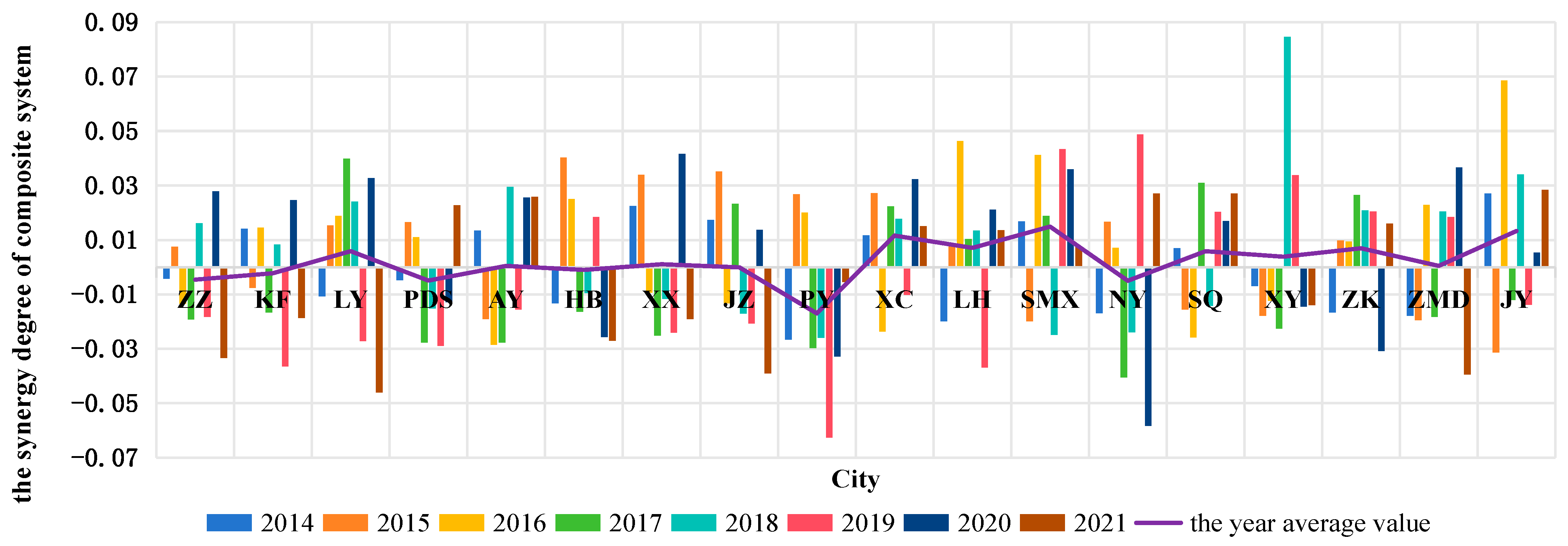
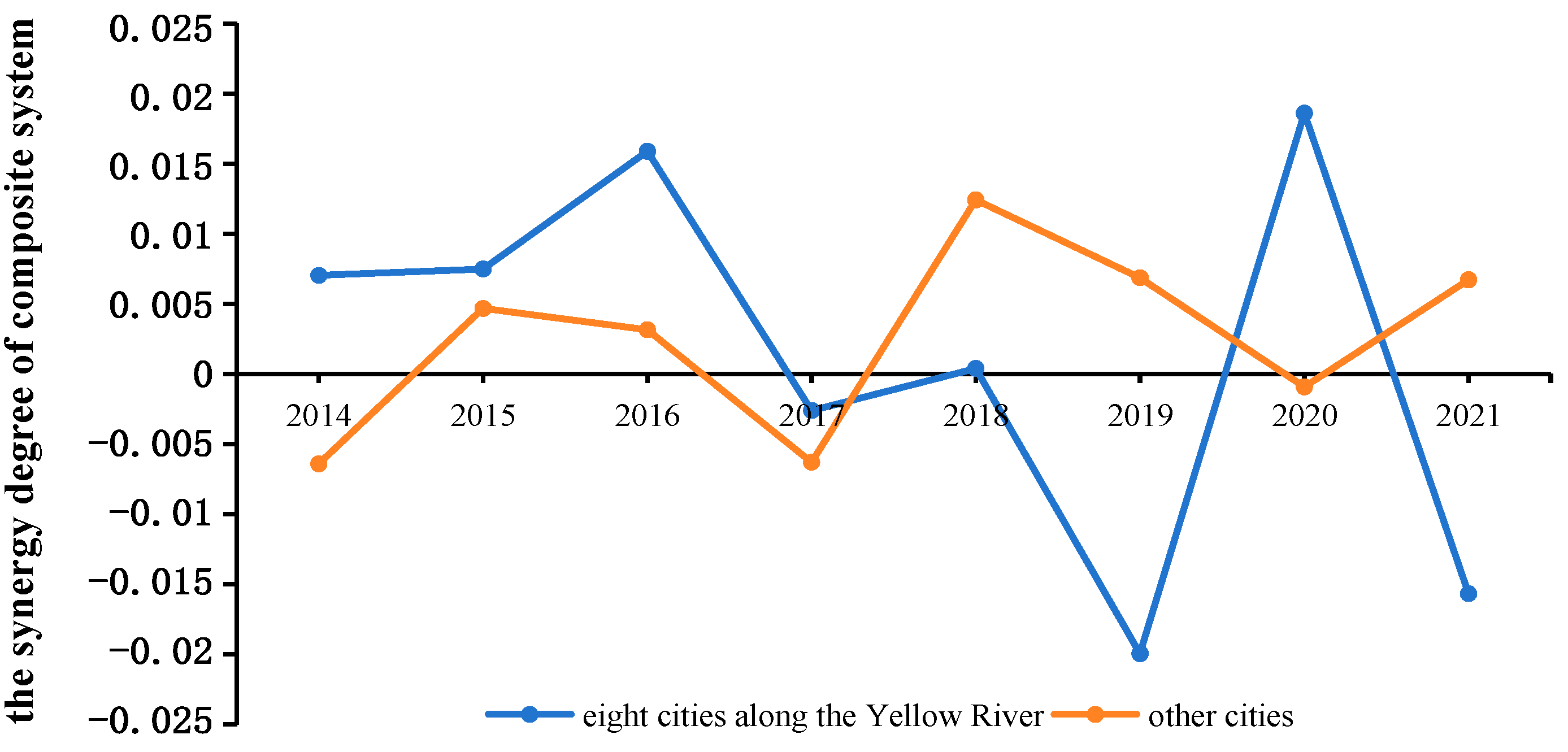
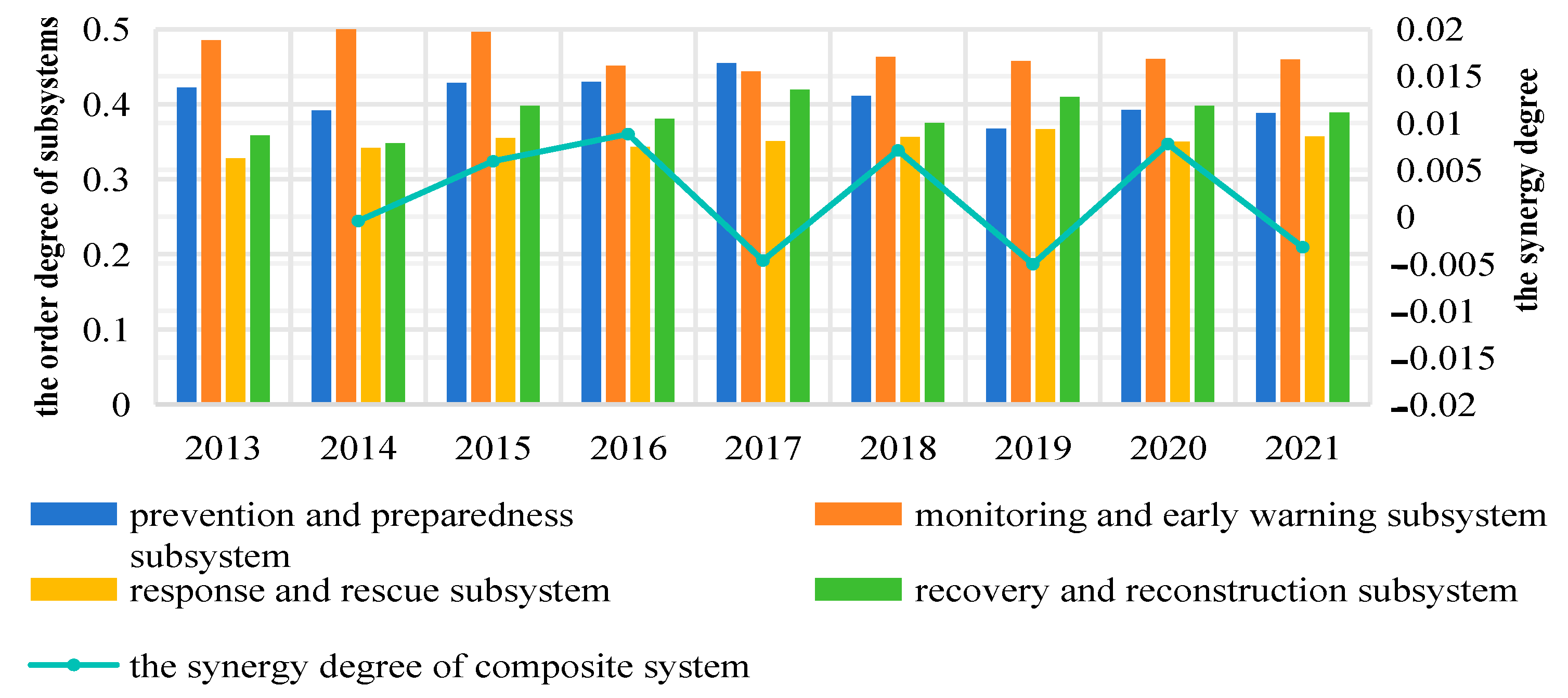
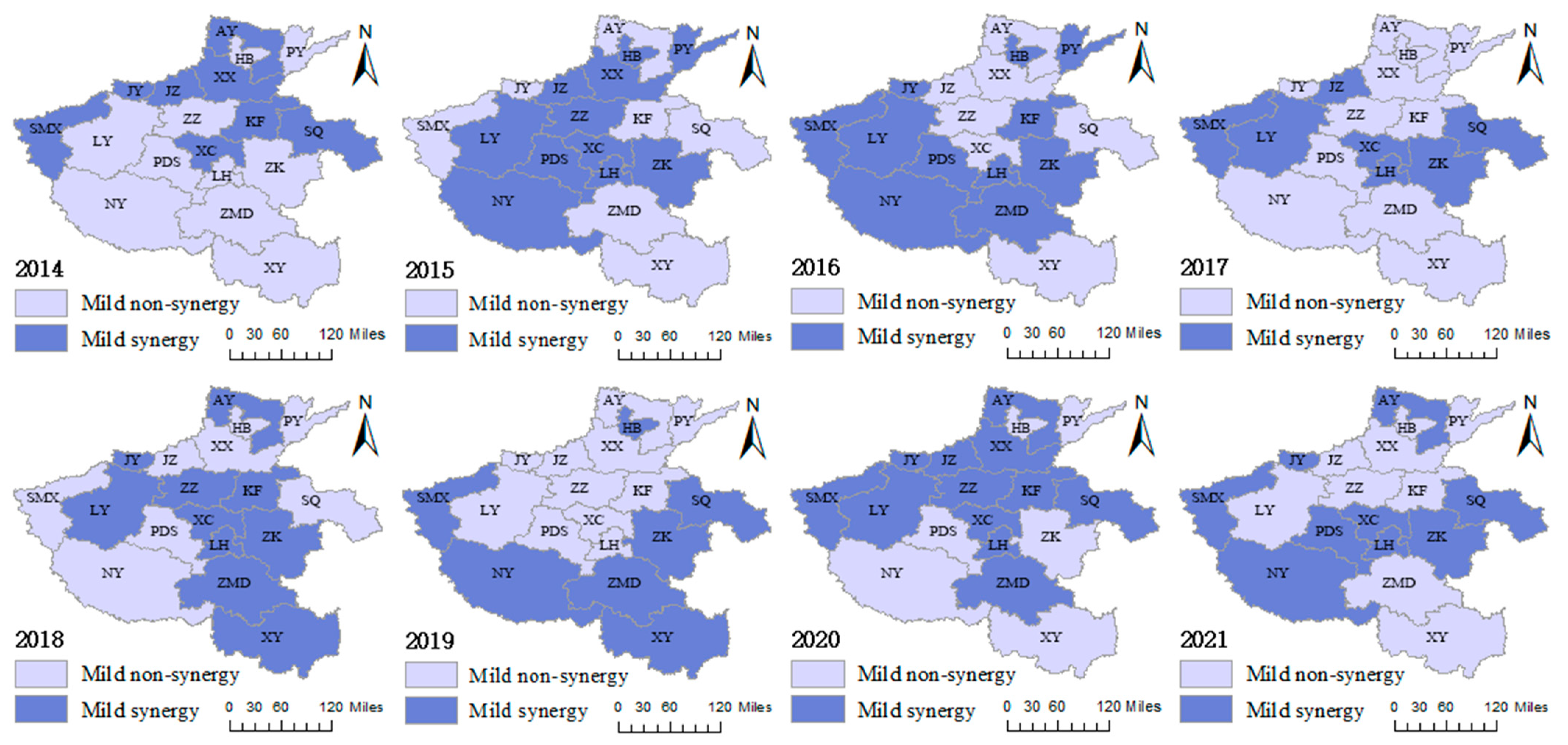
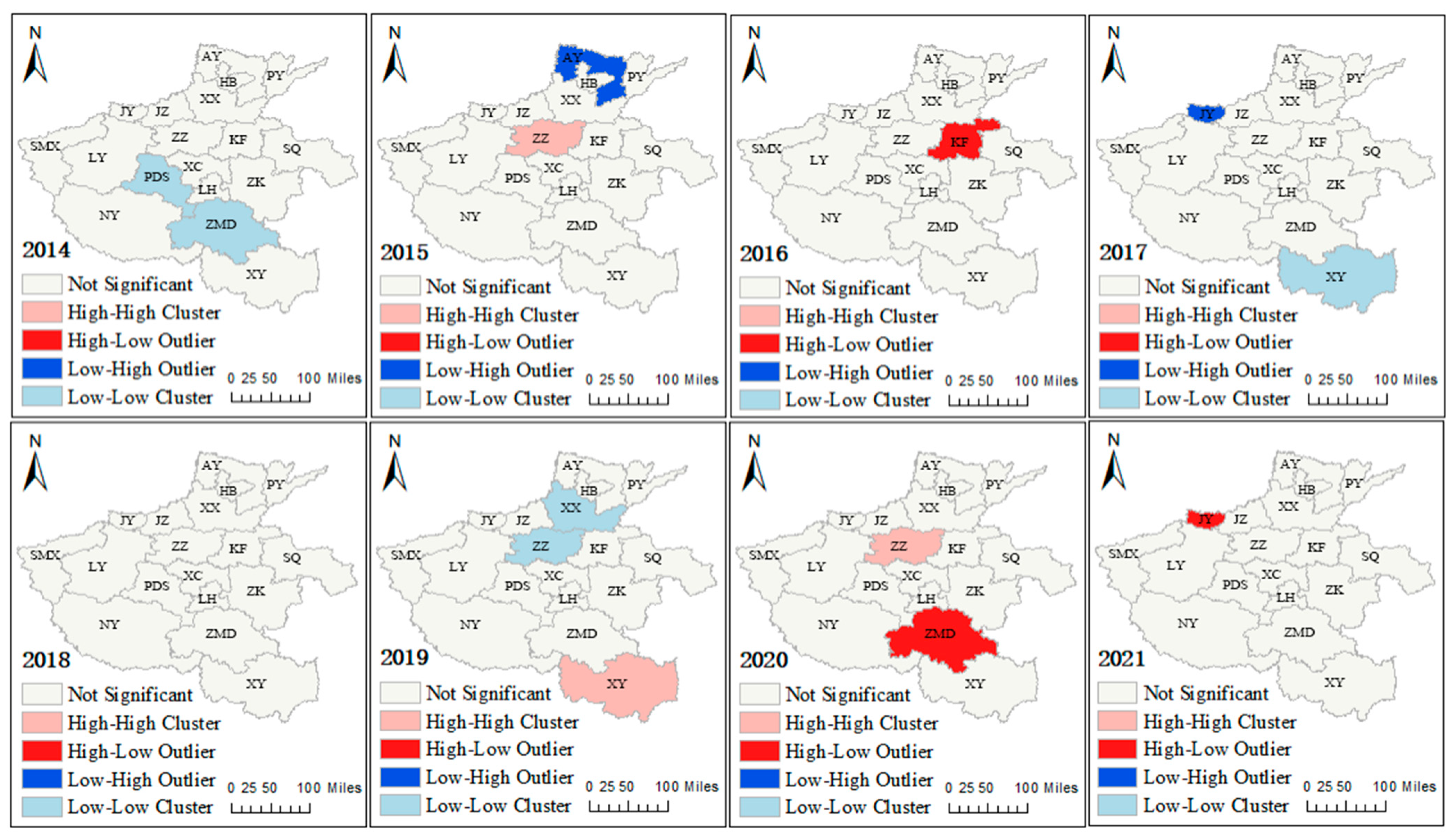
| Primary Indices | Secondary Indices | Tertiary Indices | Weight |
|---|---|---|---|
| Composite system for urban flood emergency management | Prevention and preparednesssub system | 0.141 | |
| 0.103 | |||
| 0.148 | |||
| 0.140 | |||
| 0.082 | |||
| 0.182 | |||
| 0.203 | |||
| Monitoring and early warning subsystem | 0.153 | ||
| 0.166 | |||
| 0.104 | |||
| 0.071 | |||
| 0.219 | |||
| 0.287 | |||
| Response and rescue subsystem | 0.180 | ||
| 0.142 | |||
| 0.210 | |||
| 0.100 | |||
| 0.162 | |||
| Number of flood protection projects (cumulative number of urban | 0.206 | ||
| Recovery and reconstruction subsystem | 0.084 | ||
| 0.169 | |||
| 0.046 | |||
| 0.092 | |||
| 0.133 | |||
| 0.086 | |||
| 0.076 | |||
| 0.187 | |||
| 0.127 |
| Synergy Degree | Type |
|---|---|
| −1 ≤ < −0.666 | High lack of synergy |
| −0.666 ≤ < −0.333 | Moderate lack of synergy |
| −0.333 ≤ < 0 | Mild nonsynergy |
| 0 ≤ < 0.333 | Mild synergy |
| 0.333 ≤ < 0.666 | Moderate synergy |
| 0.666 ≤ ≤ 1 | High synergy |
| City | 2014 | 2015 | 2016 | 2017 | 2018 | 2019 | 2020 | 2021 |
|---|---|---|---|---|---|---|---|---|
| Zhengzhou | −0.0042 | 0.0075 | −0.0134 | −0.0192 | 0.0161 | −0.0182 | 0.0279 | −0.0334 |
| Kaifeng | 0.0141 | −0.0076 | 0.0145 | −0.0166 | 0.0083 | −0.0365 | 0.0246 | −0.0187 |
| Luoyang | −0.0107 | 0.0153 | 0.0189 | 0.0398 | 0.0241 | −0.0271 | 0.0327 | −0.0460 |
| Pingdingshan | −0.0048 | 0.0165 | 0.0110 | −0.0277 | −0.0151 | −0.0289 | −0.0129 | 0.0227 |
| Anyang | 0.0134 | −0.0191 | −0.0285 | −0.0277 | 0.0295 | −0.0155 | 0.0256 | 0.0259 |
| Hebi | −0.0133 | 0.0402 | 0.0251 | −0.0164 | −0.0095 | 0.0185 | −0.0256 | −0.0270 |
| Xinxiang | 0.0225 | 0.0340 | −0.0094 | −0.0251 | −0.0116 | −0.0240 | 0.0415 | −0.0191 |
| Jiaozuo | 0.0173 | 0.0351 | −0.0133 | 0.0233 | −0.0170 | −0.0207 | 0.0137 | −0.0390 |
| Puyang | −0.0266 | 0.0268 | 0.0201 | −0.0297 | −0.0259 | −0.0626 | −0.0328 | −0.0054 |
| Xuchang | 0.0117 | 0.0272 | −0.0236 | 0.0224 | 0.0178 | −0.0102 | 0.0323 | 0.0151 |
| Luohe | −0.0198 | 0.0081 | 0.0463 | 0.0103 | 0.0135 | −0.0368 | 0.0212 | 0.0136 |
| Sanmenxia | 0.0168 | −0.0199 | 0.0411 | 0.0189 | −0.0248 | 0.0433 | 0.0360 | 0.0077 |
| Nanyang | −0.0169 | 0.0167 | 0.0071 | −0.0405 | −0.0239 | 0.0487 | −0.0583 | 0.0271 |
| Shangqiu | 0.0070 | −0.0155 | −0.0258 | 0.0310 | −0.0142 | 0.0203 | 0.0170 | 0.0271 |
| Xinyang | −0.0069 | −0.0178 | −0.0123 | −0.0225 | 0.0846 | 0.0338 | −0.0145 | −0.0139 |
| Zhoukou | −0.0166 | 0.0098 | 0.0094 | 0.0265 | 0.0209 | 0.0205 | −0.0308 | 0.0160 |
| Zhumadian | −0.0178 | −0.0194 | 0.0229 | −0.0183 | 0.0205 | 0.0184 | 0.0367 | −0.0394 |
| Jiyuan | 0.0271 | −0.0313 | 0.0685 | −0.0121 | 0.0341 | −0.0138 | 0.0054 | 0.0284 |
| City | 1% | 5% | 10% | City | 1% | 5% | 10% |
|---|---|---|---|---|---|---|---|
| Zhengzhou | 0.0431 | 0.2151 | 0.4288 | Xuchang | 0.0038 | 0.0188 | 0.0375 |
| Kaifeng | 0.0342 | 0.1713 | 0.3434 | Luohe | 0.0850 | 0.4228 | 0.8403 |
| Luoyang | 0.0056 | 0.0281 | 0.0563 | Sanmenxia | 0.0130 | 0.0650 | 0.1300 |
| Pingdingshan | 0.0124 | 0.0619 | 0.1237 | Nanyang | 0.1840 | 0.9305 | 1.8880 |
| Anyang | 0.0580 | 0.2909 | 0.5843 | Shangqiu | 0.0314 | 0.1569 | 0.3130 |
| Hebi | 0.2569 | 1.2653 | 2.4849 | Xinyang | 0.0038 | 0.0191 | 0.0382 |
| Xinxiang | 0.0645 | 0.3211 | 0.6391 | Zhoukou | 0.0004 | 0.0022 | 0.0044 |
| Jiaozuo | 0.0079 | 0.0395 | 0.0790 | Zhumadian | 0.0097 | 0.0484 | 0.0970 |
| Puyang | 0.0127 | 0.0634 | 0.1267 | Jiyuan | 0.0020 | 0.0102 | 0.0205 |
| Time | Moran’s I | p Value | Z-Test Value | Variance |
|---|---|---|---|---|
| 2014 | −0.0598 | 0.9948 | −0.0065 | 0.0252 |
| 2015 | −0.1480 | 0.5737 | −0.5626 | 0.0251 |
| 2016 | −0.1205 | 0.6879 | −0.4017 | 0.0236 |
| 2017 | 0.1724 | 0.1451 | 1.4570 | 0.0252 |
| 2018 | −0.1420 | 0.5656 | −0.5746 | 0.0209 |
| 2019 | 0.2686 | 0.0363 | 2.0932 | 0.0245 |
| 2020 | −0.2923 | 0.1311 | −1.5097 | 0.0239 |
| 2021 | −0.1608 | 0.5220 | −0.6403 | 0.0254 |
| Time | 1 | 2 | 3 | 4 | 5 | |||||
|---|---|---|---|---|---|---|---|---|---|---|
| 2013 | 17.773 | 5.351 | 4.944 | 4.816 | 4.647 | |||||
| 2014 | 17.167 | 5.759 | 5.558 | 4.949 | 4.697 | |||||
| 2015 | 7.676 | 6.185 | 5.898 | 5.625 | 5.154 | |||||
| 2016 | 8.128 | 7.439 | 6.143 | 5.398 | 5.281 | |||||
| 2017 | 8.947 | 8.078 | 5.705 | 5.441 | 5.372 | |||||
| 2018 | 8.183 | 6.443 | 5.873 | 5.524 | 5.496 | |||||
| 2019 | 8.577 | 6.875 | 6.801 | 5.642 | 5.305 | |||||
| 2020 | 11.440 | 9.263 | 6.519 | 4.673 | 4.671 | |||||
| 2021 | 9.381 | 7.507 | 6.459 | 5.792 | 5.182 | |||||
Disclaimer/Publisher’s Note: The statements, opinions and data contained in all publications are solely those of the individual author(s) and contributor(s) and not of MDPI and/or the editor(s). MDPI and/or the editor(s) disclaim responsibility for any injury to people or property resulting from any ideas, methods, instructions or products referred to in the content. |
© 2024 by the authors. Licensee MDPI, Basel, Switzerland. This article is an open access article distributed under the terms and conditions of the Creative Commons Attribution (CC BY) license (https://creativecommons.org/licenses/by/4.0/).
Share and Cite
Hao, Y.; Wang, C.; Sun, C.; Liu, D. Evaluation and Spatial–Temporal Pattern Evolution of Synergy Degree of Emergency Management for Urban Flood Disasters from the Perspective of Sustainable Development—The Case of Henan, China. Sustainability 2024, 16, 4730. https://doi.org/10.3390/su16114730
Hao Y, Wang C, Sun C, Liu D. Evaluation and Spatial–Temporal Pattern Evolution of Synergy Degree of Emergency Management for Urban Flood Disasters from the Perspective of Sustainable Development—The Case of Henan, China. Sustainability. 2024; 16(11):4730. https://doi.org/10.3390/su16114730
Chicago/Turabian StyleHao, Yu, Chen Wang, Chaolun Sun, and Delin Liu. 2024. "Evaluation and Spatial–Temporal Pattern Evolution of Synergy Degree of Emergency Management for Urban Flood Disasters from the Perspective of Sustainable Development—The Case of Henan, China" Sustainability 16, no. 11: 4730. https://doi.org/10.3390/su16114730
APA StyleHao, Y., Wang, C., Sun, C., & Liu, D. (2024). Evaluation and Spatial–Temporal Pattern Evolution of Synergy Degree of Emergency Management for Urban Flood Disasters from the Perspective of Sustainable Development—The Case of Henan, China. Sustainability, 16(11), 4730. https://doi.org/10.3390/su16114730






